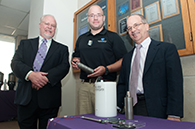Alumnus-owned company, university collaborate to innovate radiation sensor industry
Monday, May 20, 2013
MANHATTAN -- A recent Kansas State University graduate and two university laboratories are joining the forces of university and industry to commercialize radiation sensors.
Steven Bellinger, Kansas State University research associate and recent doctoral graduate in nuclear engineering, began the Manhattan-based start-up company, Radiation Detection Technologies Inc., or RDT, to solve challenges in radiation monitoring. The company is commercializing technologies developed in two Kansas State University laboratories: the Semiconductor Materials and Radiological Technologies, or SMART, Laboratory and the Electronics Design Laboratory, or EDL.
"Much of the radiation detection industry is built on legacy technologies," said Bellinger, president of the company. "This makes it difficult to advance new and innovative technologies into the commercial sector. However, because of the short supply of Helium-3, a vital element of current neutron detectors, alternatives such as the solid-state devices developed at Kansas State University fill an important niche and will advance the state-of-the-art in the industry."
Since 2002, the SMART Laboratory has pioneered research into detector materials and novel semiconductor processing to produce low-cost, high-efficiency radiation detectors. Working with SMART Laboratory researchers, EDL has developed the sensor electronics needed to customize the radiation detectors for defense, homeland security and health physics applications. The radiation sensors developed at the two laboratories are an especially attractive option for industry because they are compact and lightweight, which makes them available in small packages.
The nuclear monitoring industry not only has a demand for radiation sensors, but also a demand for improved detection capabilities.
"One of the most sensitive topics in the radiation detection industry may be the detection and identification of radiological hazards," said Douglas McGregor, professor of nuclear engineering and director of the SMART Laboratory. "Development of new and innovative radiation detectors is the mission of the SMART Laboratory. Through the improvement of radiation detection technologies and capabilities, the current and future needs for industrial practices and safeguards are better satisfied. As such, it is very beneficial to Kansas State University and the detection industry to have a commercial entity, such as Radiation Detection Technologies Inc., to move our innovations to commercially available products."
Bellinger began RDT in November 2011 and received his doctoral the next month. The company has successfully transitioned university-grown technology to the industry to deliver sensors to the Department of Energy, the Department of Defense and private industry partners. Bellinger has been collaborating with the University of Michigan, the Department of Energy and Kansas State University on licensing and patenting related to the technology.
The company addresses a gap in the radiation detection industry in both the U.S. and the world, Bellinger said. This gap is particularly noticeable because of the lack of a transition of many new and novel technologies reported in literature to the commercial sector, he said. These novel technologies are mostly practiced in academics, while major commercial companies use old or outdated technology and retreat from offering broad product lines. These companies instead seek to focus on general industrial products.
"An important step in producing instruments that can operate in a wide variety of commercial and industrial environments is the coupling of the sensor to readout and display electronics, a role in which the Electronics Design Laboratory is very experienced," said Tim Sobering, director of EDL. "The radiation detection industry is always looking for reduced power consumption and compact packages. EDL designs to these requirements while focusing on optimizing the interface to the radiation sensors developed in the SMART lab."
Industry stakeholders interested in participating in the radiation sensor development initiatives at Kansas State University should contact Douglas McGregor at 785-532-4093 or mcgregor@k-state.edu and Tim Sobering at 785-532-7826 or edl@k-state.edu. Inquiries regarding commercial products being developed from the SMART Laboratory should be directed to Steven Bellinger at 785-532-7087 or bellinger@radectech.com.
Radiation Detection Technologies Inc., or RDT, is a start-up company and spin off of the Semiconductor Materials and Radiological Technologies, or SMART, Laboratory at Kansas State University. RDT was founded in 2011 to act as a conduit for transitioning and developing commercial radiation detection technologies that have been laboratory proven by the SMART Laboratory and the Electronics Design Laboratory. RDT differentiates itself by maintaining a focus on innovative radiation detection technologies and remaining close to its customers to meet their needs with the innovative technologies continually being developed at the SMART Laboratory.
The Semiconductor Materials and Radiological Technologies, or SMART, Laboratory at Kansas State University is a unique facility dedicated to the research and development of new and innovative radiation detector technologies. The facility is in Ward Hall on the main Kansas State University campus and is available to students and faculty for research and development. The laboratory serves as a center for undergraduate and graduate student education as well as a facility to accommodate funded research projects from various government and industrial sponsors.
The Electronics Design Laboratory, or EDL, is a multidisciplinary support center at Kansas State University and supports the research programs at Kansas Regents Institutions by providing expertise in the development of high-end electronics and computer-based data acquisition systems. The laboratory was founded in 1996 as a fully equipped state-of-the-art electronics development laboratory that includes industry standard computer-aided design tools to support analog and digital circuit design, system simulation, system testing and printed-circuit board design. It occupies approximately 1,200 square feet on the main Kansas State University campus.

